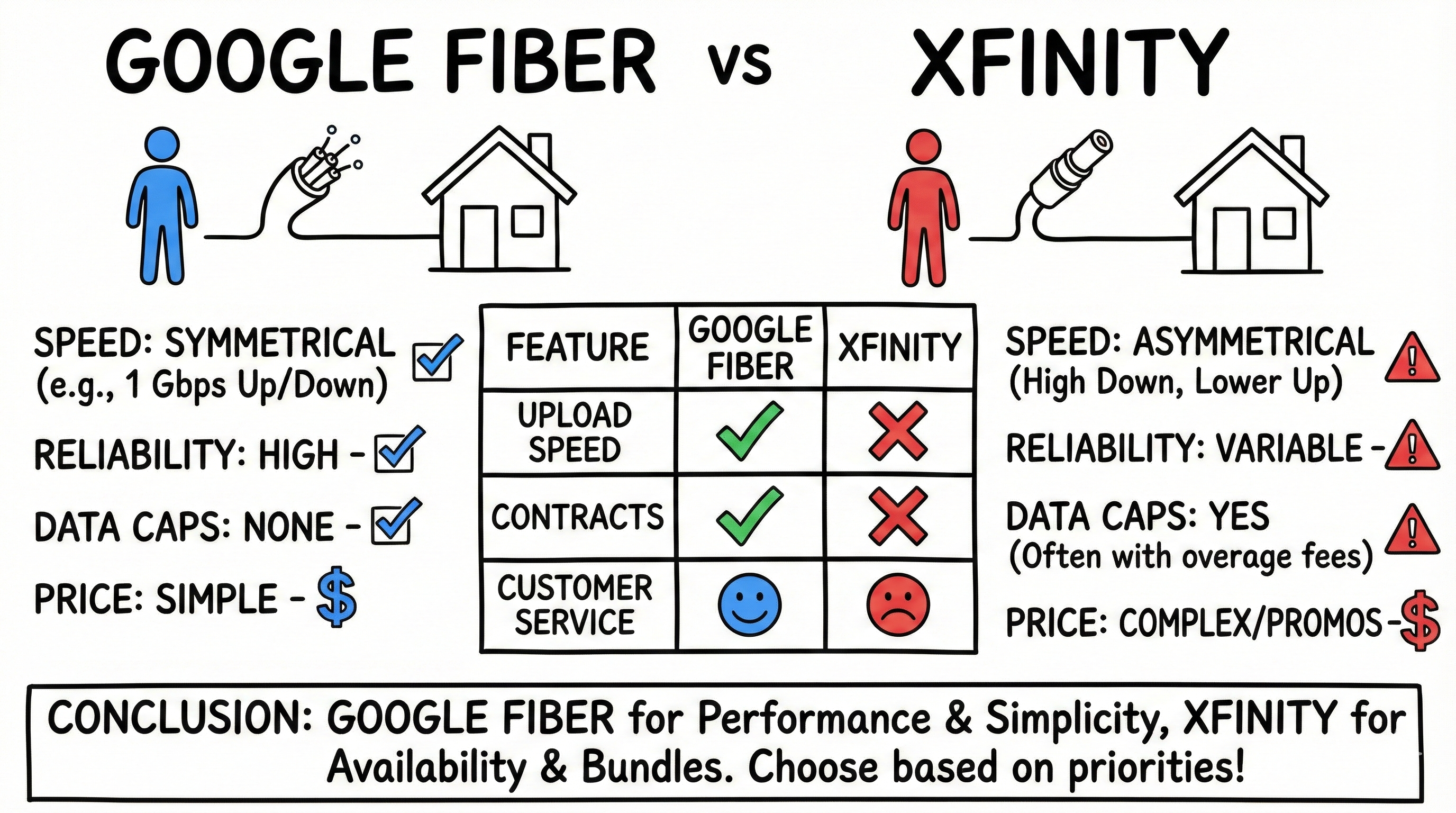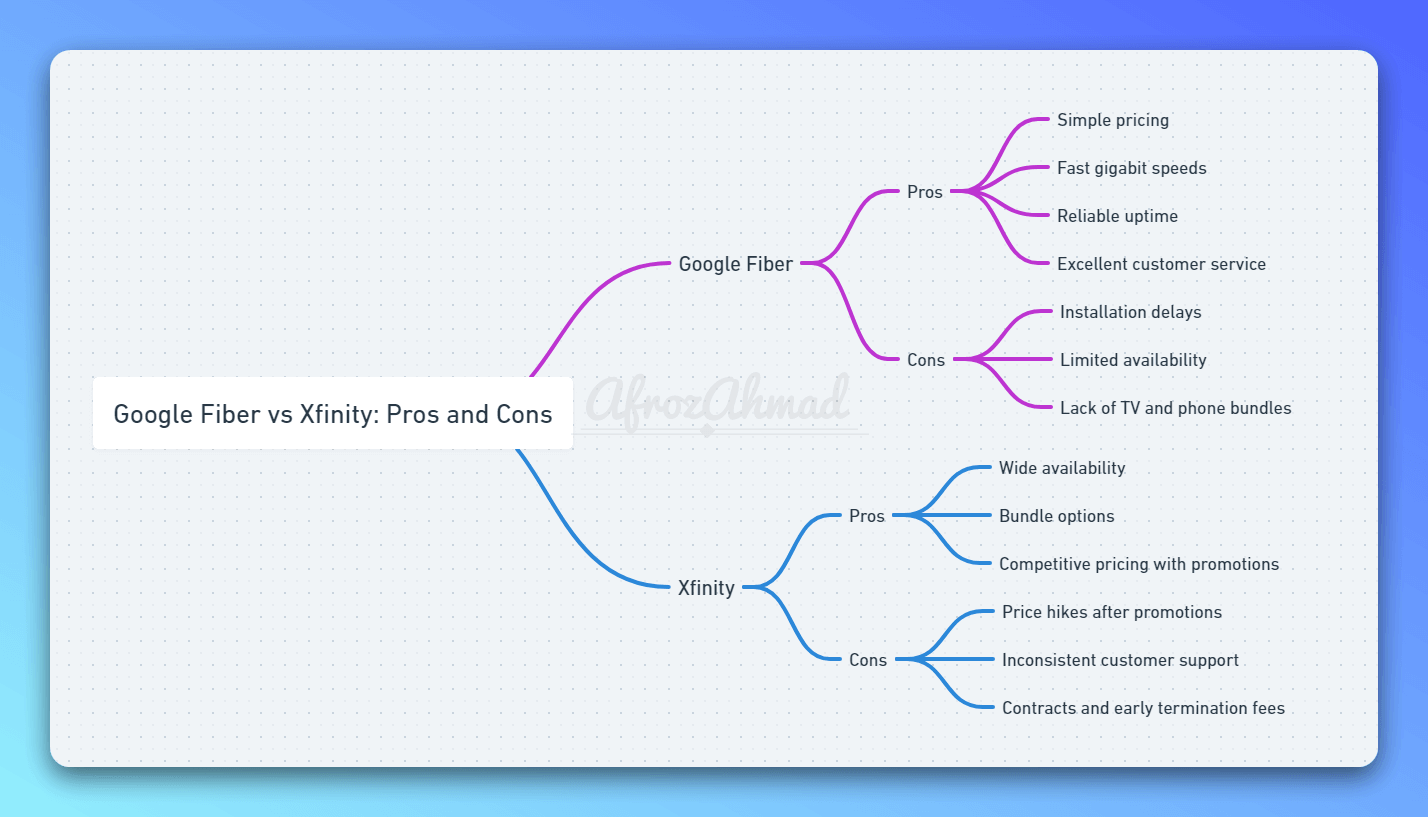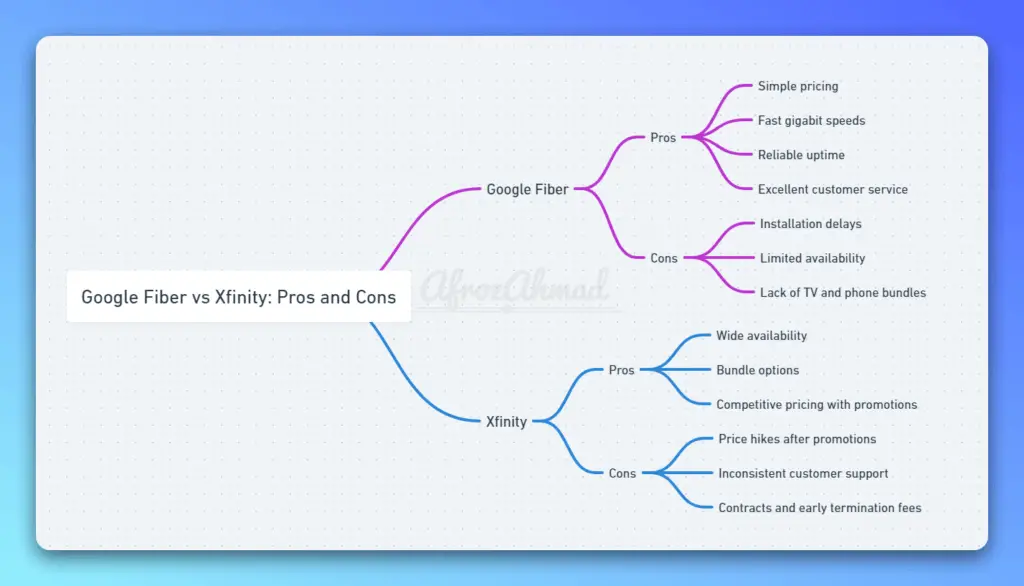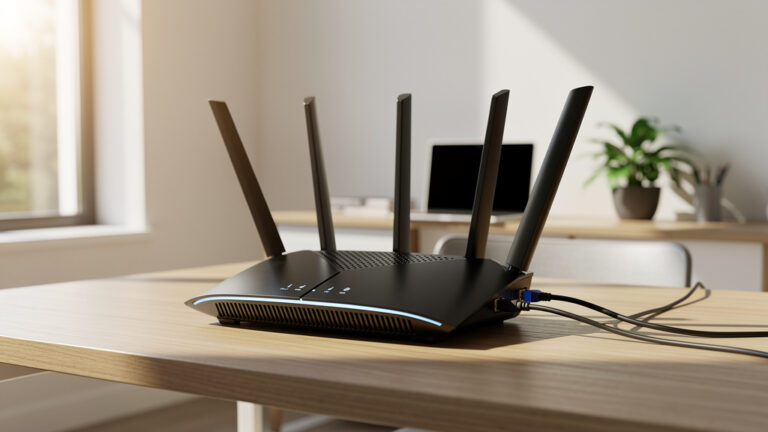In the quest for ultra-fast internet, two giants stand out: Google Fiber vs Xfinity. Google Fiber tempts with its symmetrical multi-gigabit speeds and praise-worthy customer service, while Xfinity counters with its extensive coverage and diverse bundling options.
This comparison dives deep into the nuances of each provider, evaluating everything from pricing and plans to performance and customer support. Make an informed decision on which service best matches your speed requirements and lifestyle needs without wading through fluff. Get ready for a clear-eyed look at these top-tier internet services.
Key Takeaways – Pros and Cons – Google Fiber vs Xfinity
Here is an extensive pros and cons table comparing Google Fiber and Xfinity:
| Category | Google Fiber | Xfinity |
|---|---|---|
| Speeds | – Offers symmetrical speeds up to 8 Gbps (8000 Mbps) – Extremely low latency ideal for gaming – Consistent and reliable with minimal variation | – Maximum cable speeds up to 2 Gbps – Fiber plans up to 10 Gbps in select areas – Slower uploads than downloads on most cable plans – More peak time slowdowns on cable |
| Pricing | – Simple pricing from $70-$150/month – No contracts or commitments – No data caps – Free standard installation – No hidden fees | – Wide range of plans from $20-$299+/month – Bundles available for discounts – 1 or 2 year contracts common – Many extra fees like equipment/activation fees – Data overage charges on some plans |
| Availability | – Available in over 30 metro areas and expanding – Must enter address to check eligibility | – Available in 40 states – Widespread coverage makes it easily available |
| Installation | – Free professional installation included – Clean and neat wiring done – Long waits for installation appointments possible | – Self-install is free – Professional install costs extra (around $100) – Quality can vary |
| Reliability | – Extremely consistent uptimes – Fiber network not prone to congestion issues | – Good overall reliability – More potential for outages than fiber – Slowdowns during peak times on cable network |
| Customer Service | – 24/7 support with minimal wait times – Knowledgeable support agents – Consistently high satisfaction ratings | – Multiple support channels available – Inconsistent experiences – Long holds frequently reported |
| Extra Features | – Encourages streaming TV (e.g., YouTube TV) – Includes Chromecast with Google TV on some plans – Limited services beyond internet | – Bundles with TV, home security, mobile – Integrated packages and billing – Free Peacock Premium with some plans |
| Contracts | – No contracts – Cancel Google Fiber anytime | – 1 or 2-year contracts common – Early termination fees |
| Data Caps | – No data caps | – 1.2 TB monthly data cap on many plans – Overage fees apply or pay for unlimited |
| Equipment Fees | – No equipment fees for standard router | – $14/month modem rental fee (or purchase your own) |
| Connection Type | – 100% fiber optic network | – Primarily cable internet (HFC) – Offers fiber-to-the-home in limited areas |
| Performance | – Symmetrical speeds, low latency and jitter – Even speeds 24/7 | – Good speeds when uncongested – Peak slowdowns possible – Upload speeds slower than download on cable |
In summary:
- Google Fiber’s pros include uncomplicated pricing, blazing-fast symmetrical speeds, reliability, and outstanding customer service. The main downside is its limited availability.
- Xfinity’s pros are its widespread availability, range of bundle options, and competitive introductory pricing. Cons include contracts, extra fees, asymmetrical speeds on cable, and inconsistent customer service experiences.

What is Google Fiber?
Google Fiber is a subsidiary of Alphabet Inc. that provides fiber-to-the-premises internet connectivity. The service first launched in 2010 in the Kansas City metropolitan area and has been expanding ever since.
Some key things to know about Google Fiber:
- Pure Fiber Network: Google Fiber delivers internet over a 100% fiber-optic network, which allows for symmetrical speeds (equal download and upload) up to 8 Gbps. This makes it one of the fastest residential internet services available.
- Growing Availability: While still more limited than cable, Google Fiber is available or expanding in over 30 metropolitan areas across states like Arizona, Colorado, Georgia, Iowa, Illinois, Kansas, Missouri, North Carolina, Tennessee, Texas, and Utah.
- Straightforward Plans: Google Fiber offers simple, transparent plans. These typically include 1 Gig, 2 Gig, 5 Gig, and 8 Gig options. There are no contracts, data caps, or hidden fees.
- Expanding Service: Google continues to build out its network in existing cities and announce new markets, focusing on bringing multi-gigabit speeds to more homes.
- Strong Customer Satisfaction: Google Fiber routinely receives high marks for customer service, speed, and reliability. Customers appreciate the easy-to-understand plans and pricing.
In areas where Google Fiber is available, it offers some of the fastest residential internet speeds at very competitive pricing. The reliability and performance of the network make it appealing for households with many connected devices or data-intensive activities.
If you’re considering upgrading your ethernet cables, our comparison of Cat 5 vs Cat 5e vs Cat 6 vs Cat 6a vs Cat 7 vs Cat 8 can help you decide which is best for your needs.
Overview of Xfinity
Xfinity from Comcast is the nation’s largest cable internet provider, offering service to tens of millions of customers across 40 states.
Here are some important things to note about Xfinity internet service:
- Cable and Fiber Networks: Xfinity primarily delivers internet over its Hybrid Fiber-Coaxial (HFC) cable network, but also offers fiber-to-the-home in limited areas. Maximum cable speeds reach up to 2 Gbps in select markets, with the premium Gigabit Pro fiber plan reaching up to 10 Gbps.
- Broad Availability: With an extensive cable network run throughout most of the US, Xfinity availability is much greater than Google Fiber. However, exact plan options and speeds vary by location.
- Range of Plans: Xfinity offers numerous internet plans ranging from 75 Mbps to 2 Gbps, with varying price points from around $20–$120/month for cable plans. Bundles with TV, mobile, and home phone are also available.
- Contracts and Data Caps: Many Xfinity plans require 1- or 2-year contracts for the best pricing. A data cap of 1.2 TB/month applies to most plans, but unlimited data can be added for an extra fee.
- Extra Fees: In addition to the base internet price, Xfinity often charges fees like an equipment rental fee (around $14/month), professional installation fee, and activation fees.
Overall, Xfinity offers fast, reliable internet with the advantage of widespread availability. But some downsides exist like contracts, data caps, and add-on fees that customers should be aware of.
Speed and Performance Comparison
When it comes to speed and performance, a 100% fiber internet connection has technological advantages over cable. Let’s see how Google Fiber and Xfinity compare in real-world use.
Internet Speeds
- Google Fiber offers symmetrical plans of 1 Gbps, 2 Gbps, 5 Gbps, and 8 Gbps. This means your upload speed is just as fast as your download speed.
- Xfinity’s lineup includes cable plans from 75 Mbps up to 1.2 Gbps (Gigabit Extra) and even 2 Gbps in some areas. However, upload speeds on these plans are much slower than download speeds, though they are improving in many markets. Xfinity’s premium fiber plan, Gigabit Pro, can reach symmetrical speeds up to 10 Gbps.
In practical use, Google Fiber’s symmetrical speeds provide a significant advantage for activities like video conferencing, uploading large files, and live streaming. Xfinity provides excellent download speeds, but the lower upload speeds on its cable plans can be a bottleneck for power users.
Reliability and Consistency
Google Fiber’s 100% fiber-optic network provides extremely reliable and consistent performance. Because each customer can have a dedicated line, the network is less prone to congestion, and speed variations are minimal, even during peak usage times.
Xfinity’s cable network is susceptible to more fluctuations during peak usage times in neighborhoods where the local infrastructure is shared among many homes. While quite reliable overall, slowdowns are more likely during evenings. To combat this and boost upload speeds, Xfinity is actively upgrading its network with “mid-split” architecture and the new DOCSIS 4.0 standard, which will significantly improve performance and reliability on its cable network over time.
If you’re suffering from slow upload speeds, our blog post on why your upload speed might be slow can help identify and resolve the issue.
Latency
Latency, or ping, is the time it takes for data to travel from your device to a server and back. Lower latency is crucial for a responsive online experience, especially in gaming and video calls.
Typical latency is under 20ms for Google Fiber customers, thanks to the efficiency of light signals traveling through fiber glass. Xfinity cable internet latency is also very good, generally ranging from 20-40ms depending on location and network conditions.
For competitive online gaming and other real-time applications, Google Fiber’s extremely low and stable latency gives it a performance edge.
Multi-Gigabit Plans: Comparing the Fastest Speeds
Both providers are pushing the boundaries of residential internet with multi-gigabit plans. This is where the competition gets interesting for users who demand the absolute best performance.
Google Fiber’s Multi-Gig Tiers
Google Fiber offers several multi-gig options, all of which are symmetrical (equal download and upload speeds):
- 2 Gig: Around $100/month. Ideal for power users, streamers, and large households with dozens of connected devices.
- 5 Gig: Around $125/month. Aimed at creative professionals, data scientists, and tech enthusiasts who transfer massive files regularly.
- 8 Gig: Around $150/month. This top-tier plan is for those who need enterprise-level speed at home, pushing the limits of current consumer hardware.
Xfinity’s Multi-Gig Tiers
Xfinity is also rolling out multi-gig speeds, though the technology and availability vary:
- Gigabit x2: Up to 2 Gbps symmetrical speeds for around $120/month. This plan uses DOCSIS 4.0 technology over Xfinity’s cable network and is available in select, newly upgraded markets.
- Gigabit Pro: Up to 10 Gbps symmetrical speeds. This is a premium fiber-to-the-home service with very limited availability and a much higher price point (around $299.95/month, plus installation costs). It requires a professional survey to determine eligibility.
While Google Fiber offers more accessible and widespread multi-gig options, Xfinity’s network upgrades show its commitment to competing at the highest speed tiers. For most users in overlapping areas, Google Fiber’s multi-gig plans currently offer better value and simplicity.
Coverage and Availability
When considering an internet provider, the most important factor is whether service is available at your address. Google Fiber and Xfinity differ significantly in their coverage footprint.
Google Fiber Availability
Google Fiber’s availability, while growing, is still its biggest limitation. Service is available in select neighborhoods within 30+ metropolitan areas. Google Fiber’s availability is targeted and limited compared to major cable providers.
You must enter your specific address on the Google Fiber website to confirm if your home is serviceable. Availability is often concentrated in denser urban and suburban areas, including apartments and condos.
Xfinity Availability
As the nation’s largest provider, Xfinity offers service in 40 states and is available to a massive percentage of US households. It has major coverage on the East and West Coasts and throughout the Midwest. The best way to know for sure what plans are available to you is to enter your address on the Xfinity website.
Xfinity’s vast network means it’s far more likely to be an option for your home, especially in suburban and rural-edge communities where fiber has not yet been built.
For those new to Xfinity, our guide on how to activate your Xfinity modem can streamline the setup process.
Pricing and Plans
When selecting internet service, pricing is a primary factor. Here’s how the costs of plans, fees, and contracts compare between Google Fiber and Xfinity.
Google Fiber Plans and Pricing
Google Fiber offers straightforward pricing with no annual contracts. While plans can vary slightly by city, the common tiers are:
- 1 Gig: Symmetrical 1000 Mbps speeds for $70/month
- 2 Gig: Symmetrical 2000 Mbps speeds for $100/month
- 5 Gig: Symmetrical 5000 Mbps speeds for $125/month
- 8 Gig: Symmetrical 8000 Mbps speeds for $150/month
Taxes are the only potential additional fee. All Google Fiber plans include:
- Unlimited data
- Free standard professional installation
- WiFi router rental included
- No data caps, contracts, or hidden fees
Overall, pricing is transparent and simple with Google Fiber. You pay a reasonable monthly fee for exceptionally fast fiber speeds with no restrictions.
Xfinity Plans and Pricing
Xfinity offers a wide array of internet plans with varying speeds and term lengths. Pricing is highly dependent on your location and whether you are signing up for a promotional offer.
Here is a general overview of Xfinity internet plans:
- Connect – 75 Mbps / $20–$30/month
- Connect More – 200 Mbps / $35–$55/month
- Fast – 400 Mbps / $55–$75/month
- Superfast – 800 Mbps / $65–$85/month
- Gigabit Extra – 1200 Mbps / $80–100/month
- Gigabit x2 – 2000 Mbps / $120/month (Limited availability)
- Gigabit Pro – up to 10000 Mbps / $299.95/month (Extremely limited availability)
Most of the best prices require a 12 or 24-month contract and will increase significantly after the promotional period. Equipment, installation, and activation fees can add $150 or more to the initial cost. Data overage charges may also apply if you exceed the 1.2 TB monthly data cap on most plans.
Installation and Setup for Xfinity and Google Fiber
The installation and setup process also impacts the overall service experience. Here’s what to expect with Google Fiber and Xfinity.
Google Fiber Installation Process
Google Fiber installation includes professionally running a fiber line directly into your home, which is included at no extra cost for a standard setup. The process takes 2-4 hours depending on the residence.
Here are the steps to get Google Fiber service installed:
- Schedule an appointment online after confirming availability.
- A technician determines the optimal route for the fiber cable from the street to your home.
- The fiber line is connected to a small box on your home’s exterior.
- A small hole is drilled through an exterior wall to bring the fiber inside and set up the network jack.
- The included router and any mesh extenders are set up.
- The technician activates service and tests speeds on your devices to ensure everything is working correctly.
Google guarantees the technician will keep your property tidy and minimize wall holes after installation. Overall, you can expect highly professional installation service coordinated by Google.
Xfinity Installation Options
To get Xfinity service, you can either self-install or pay for professional installation:
Self-Installation Kit
- Free of charge. Xfinity ships you a kit or you can pick one up at an Xfinity store.
- You connect the coaxial cable to an active cable outlet and the modem, then activate your service through the Xfinity app.
- This is a great option if your home has been previously serviced by cable.
Professional Installation
- Costs around $100.
- A technician comes to your home, runs any necessary cables, installs outlets, and ensures your service is working properly.
- This is required if your home isn’t already wired for cable service.
Overall, the installation experience can vary more with Xfinity based on your setup scenario and whether you choose the DIY route.
Customer Support and Satisfaction
Having reliable customer support is vital when issues inevitably come up with your internet service. Here’s how Google Fiber and Xfinity compare when you need help.
Google Fiber Customer Support
Google Fiber earns exceptionally positive reviews for customer service and support:
- 24/7 phone, chat, and email support – Direct access to live agents with minimal wait times.
- Knowledgeable experts – Representatives are well-trained and familiar with complex fiber issues.
- Quick resolution times – Most issues are fixed efficiently with proactive communication.
In recent American Customer Satisfaction Index (ACSI) surveys, fiber internet providers consistently outperform cable providers. While Google Fiber isn’t always broken out individually, its reputation for high satisfaction aligns with the top performance of the fiber category.
Google Fiber customers frequently cite pleasant and painless support interactions. The most common complaints are occasional delays in the initial installation schedule.
Xfinity Customer Support
Xfinity gets more mixed reviews when it comes to customer service and support response:
- Phone, online chat, and mobile app – Multiple support channels with varying wait times.
- Inconsistent experiences – Some reps are very knowledgeable, while others seem to lack training.
- Average resolution times – Wait times of over an hour are not uncommon for complex issues.
Third-party surveys like the ACSI typically rate Xfinity’s customer satisfaction below the industry average for ISPs, though the company has been working to improve its scores.
Reviews highlight inconsistent experiences—some customers get quick resolution while others face frustrating issues getting the right help. Long hold times are a commonly cited complaint. However, local repair technicians generally offer good service once dispatched.
Additional Features and Offerings
Beyond just internet service, providers like Xfinity and Google Fiber offer other features and bundles that may appeal to customers.
Google Fiber Features
Google Fiber’s focus is on delivering a simple, high-performing internet product. It has moved away from traditional service bundles.
A few extra features include:
- Streaming TV Focus: Google Fiber no longer offers a traditional cable TV package. Instead, it encourages customers to use streaming services and often partners with providers like YouTube TV or FuboTV.
- Chromecast with Google TV: New customers on certain plans often receive a complimentary Chromecast with Google TV, making it easy to access streaming apps.
- Google Fiber Phone: A VoIP-based home phone service is available as an add-on for a small monthly fee.
- 1 TB Google Drive storage: This benefit was previously offered but has been discontinued for new customers.
Overall, Google Fiber does not provide extensive bundles. The strategy is to provide best-in-class internet and let customers choose their other services a la carte.
Xfinity Features
As a large cable company, Xfinity excels at offering customers comprehensive bundles and additional services:
- Xfinity TV: Hundreds of channel options with the advanced X1 cloud DVR platform.
- Xfinity Mobile: A cellular plan that uses Verizon’s network at a lower cost for Xfinity internet customers. Includes 5G access.
- Xfinity Home Security: A professionally monitored security system that integrates with your Xfinity services.
- Xfinity xFi: An app-based platform to monitor and control your home WiFi network, including advanced security and parental controls.
- Peacock Premium: Access to NBCUniversal’s Peacock streaming service is often included with certain Xfinity internet or TV plans.
For customers seeking a complete bundle with TV, internet, phone, and home security on a single bill, Xfinity provides a compelling, integrated solution.
User Reviews and Experiences
It’s helpful to examine actual customer reviews and experiences with Google Fiber and Xfinity. Here are some candid pros and cons mentioned frequently by users of each service.
Google Fiber Review
Positive Feedback
- Simple, transparent pricing with no surprises.
- Extremely fast and symmetrical speeds as advertised.
- Rock-solid reliability and uptime.
- Helpful, responsive, and pleasant customer service.
Negative Feedback
- Installation can sometimes be delayed or rescheduled.
- Limited availability is the biggest frustration.
- Lack of traditional TV bundles for those who prefer them.
Xfinity Review
Positive Feedback
- Good value for the speed, especially on an introductory promotion.
- Reliable performance for most activities like streaming and gaming.
- Availability almost everywhere makes it a convenient option.
- Bundles allow for one bill for multiple services.
Negative Feedback
- Sudden, steep price hikes after promotional periods end.
- Inconsistent customer support experiences and long hold times.
- Data caps can be restrictive for heavy users.
- Contracts and early termination fees are frustrating.
Key takeaways from user reviews:
- Google Fiber customers overwhelmingly praise the incredibly fast, reliable speeds and simple pricing. The main complaint is simply not being able to get it.
- Xfinity reviews are more mixed. Customers appreciate the convenience and availability but are often frustrated by pricing structures, data caps, and customer support interactions.
Conclusion
Google Fiber and Xfinity both offer high-speed internet options but have meaningful differences in technology, availability, pricing, and performance.
For customers lucky enough to live in a Google Fiber region, the service provides an outstanding combination of symmetrical multi-gig speeds, reliability, and customer service. The straightforward, contract-free pricing is a major advantage. If it’s available at your address, it is almost always the superior choice.
Xfinity remains a strong and capable option that serves millions of households where fiber is not yet available. Its cable network delivers fast download speeds, and its ongoing upgrades are improving upload performance. The ability to bundle TV, mobile, and other services is a key benefit for many. However, be prepared to navigate promotional pricing, contracts, and data caps.
In the end, your choice will likely be determined by availability. If you have a choice, prioritizing symmetrical speeds and transparent pricing makes Google Fiber the winner. If not, Xfinity is a powerful and widely available alternative.
Frequently Asked Questions – FAQs
Is it worth switching to google fiber?
Yes, if Google Fiber is available at your address, it is almost always worth switching. You will likely get faster, more reliable, symmetrical speeds with simpler, more transparent pricing and no data caps or annual contracts compared to most cable plans.
What is xfinity and google fiber?
What is Xfinity?
Xfinity is the brand name for Comcast’s internet, TV, and phone services. It primarily uses a hybrid fiber-coaxial (cable) network to provide high-speed internet to tens of millions of customers across 40 states. Cable speeds can reach up to 2 Gbps in select areas.
What is Google Fiber?
Google Fiber is an internet service provider owned by Alphabet Inc. that operates a 100% fiber-optic network. It offers symmetrical internet speeds up to 8 Gbps (8000 Mbps). Its availability is limited to select neighborhoods within 30+ metro areas but is continuously expanding.
- How to Configure a Secure Site-to-Site VPN on Cisco Firepower Complete Guide - December 3, 2025
- Jobs for Network Engineers: Roles, Skills & Pay - December 3, 2025
- How to Change WiFi Password on Any Router : The Last Guide You Need - December 1, 2025




